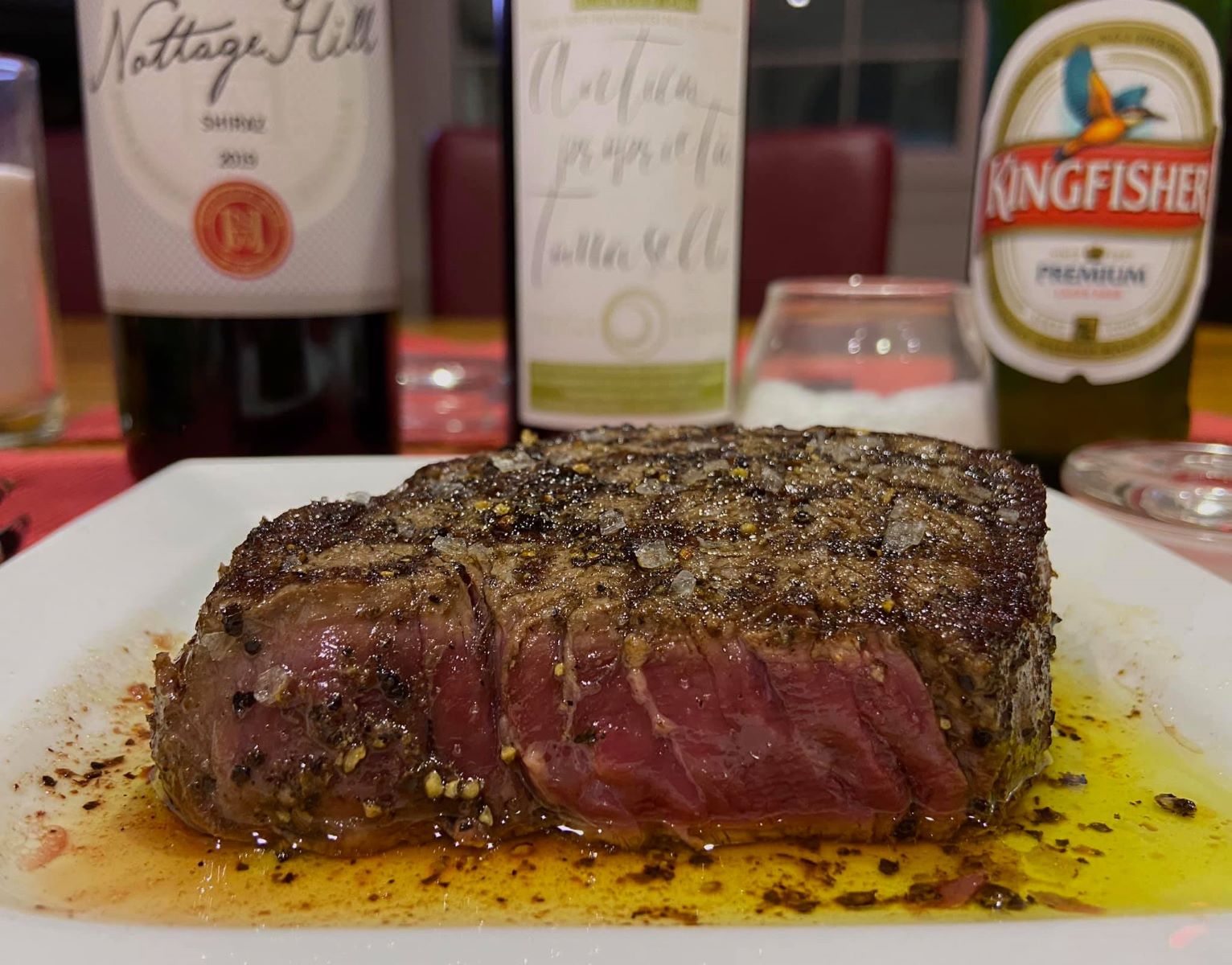Home>Food and Cooking>The Ultimate Guide To Different Steak Cuts: Fillet, T-Bone, And Porterhouse Explained!


Food and Cooking
The Ultimate Guide To Different Steak Cuts: Fillet, T-Bone, And Porterhouse Explained!
Published: January 31, 2024
Discover the ultimate guide to different steak cuts, including fillet, T-bone, and Porterhouse, in this comprehensive article. Explore the best cooking methods and tips for each cut. Perfect for food and cooking enthusiasts!
(Many of the links in this article redirect to a specific reviewed product. Your purchase of these products through affiliate links helps to generate commission for Regretless.com, at no extra cost. Learn more)
Table of Contents
Introduction
When it comes to indulging in a succulent and flavorful steak, understanding the different cuts is essential. Each steak cut offers a unique texture, tenderness, and flavor profile, making it crucial for steak enthusiasts to explore the nuances of fillet, T-bone, and Porterhouse steaks. Whether you're a seasoned steak aficionado or a curious culinary enthusiast, delving into the world of steak cuts is a journey that promises to elevate your appreciation for this beloved dish.
Steak, a timeless classic in the realm of culinary indulgence, has the power to captivate the senses and ignite a passion for the art of grilling and savoring. From the melt-in-your-mouth tenderness of fillet steak to the rich, marbled perfection of T-bone and Porterhouse cuts, each variety holds its own allure, inviting connoisseurs to savor the distinct characteristics that set them apart.
As we embark on this exploration of steak cuts, prepare to unravel the mystery behind the delectable flavors and textures that define each type. Through this comprehensive guide, you'll gain a deeper understanding of the intricate differences between fillet, T-bone, and Porterhouse steaks, empowering you to make informed decisions when selecting, preparing, and savoring these culinary delights. So, let's embark on this flavorful journey and unravel the secrets of these tantalizing steak cuts, each with its own story to tell and a palate to enchant.
Understanding Steak Cuts
Steak cuts play a pivotal role in determining the overall dining experience, influencing factors such as tenderness, flavor, and cooking methods. Understanding the distinctions between various steak cuts is essential for making informed choices and unlocking the full potential of these culinary delights.
Each steak cut is derived from specific sections of the animal, showcasing unique characteristics that set them apart. The fillet, T-bone, and Porterhouse steaks stand out as prime examples, each offering a distinct composition and flavor profile.
Tenderloin, the source of fillet steak, is located within the short loin and sirloin primal cuts. Known for its exceptional tenderness, the fillet boasts a lean texture and subtle flavor, making it a sought-after choice for those who appreciate a delicate, melt-in-your-mouth experience. In contrast, T-bone and Porterhouse steaks feature a T-shaped bone that divides two prime cuts: the tenderloin and the top loin. This results in a unique combination of textures and flavors, with the tenderloin offering a buttery tenderness and the top loin delivering rich, beefy flavors.
Moreover, the marbling of fat within these cuts significantly influences their tenderness and flavor. Fillet steak, being lean, tends to be exceptionally tender but lacks the depth of flavor found in T-bone and Porterhouse cuts, which benefit from well-distributed marbling, enhancing their succulence and taste.
Understanding the anatomy and characteristics of these steak cuts empowers enthusiasts to select the most suitable option based on their preferences and cooking methods. Whether it's the delicate tenderness of fillet steak, the robust flavors of T-bone, or the generous portions of both cuts in a Porterhouse, each variation offers a unique gastronomic experience.
By unraveling the intricacies of steak cuts, individuals can elevate their culinary prowess, ensuring that every dining experience is a celebration of exquisite flavors and unparalleled tenderness. This knowledge serves as a gateway to mastering the art of preparing, grilling, and savoring these delectable cuts, enriching the dining table with moments of pure gastronomic delight.
Fillet Steak
Fillet steak, also known as tenderloin, is revered for its exceptional tenderness and subtle flavor, making it a prized choice among steak enthusiasts. Derived from the tenderloin muscle located in the short loin and sirloin primal cuts of the animal, fillet steak embodies a luxurious dining experience characterized by its lean texture and melt-in-your-mouth tenderness.
One of the defining features of fillet steak is its minimal intramuscular fat content, which contributes to its exceptionally tender quality. This lack of marbling sets it apart from other steak cuts, such as ribeye or T-bone, where marbling plays a significant role in enhancing flavor and juiciness. As a result, fillet steak is renowned for its delicate, almost buttery texture, appealing to those who prefer a leaner yet indulgent dining experience.
When it comes to cooking fillet steak, its leanness requires careful attention to prevent overcooking, which can compromise its tenderness. Whether it's pan-searing, grilling, or broiling, fillet steak demands precision and a keen eye to achieve the perfect level of doneness while preserving its delicate texture. Additionally, the subtle flavor of fillet steak allows it to harmonize beautifully with various seasonings and sauces, offering a versatile canvas for culinary creativity.
Due to its exceptional tenderness and refined flavor profile, fillet steak is often regarded as a prime choice for special occasions and fine dining experiences. Its luxurious texture and understated yet sophisticated taste make it a popular selection for celebratory meals, romantic dinners, and gourmet gatherings. Whether served as a classic Chateaubriand, elegantly paired with a red wine reduction, or simply seasoned with salt and pepper to let its natural flavors shine, fillet steak never fails to captivate the senses and elevate the dining experience.
In essence, fillet steak embodies a culinary indulgence that celebrates tenderness and understated elegance. Its lean composition, melt-in-your-mouth texture, and versatility in flavor pairings make it a timeless favorite among steak aficionados, offering a glimpse into the refined art of savoring exceptional cuts of beef. Whether enjoyed in a high-end steakhouse or prepared with care at home, fillet steak promises a dining experience that is both exquisite and unforgettable.
T-Bone Steak
T-bone steak, a quintessential symbol of indulgence and robust flavors, stands as a testament to the artistry of steak cuts. Named for the T-shaped bone that runs through its center, this iconic cut offers a delectable marriage of two distinct beef sections: the tenderloin and the top loin. As a result, T-bone steak presents a tantalizing juxtaposition of textures and flavors, making it a favored choice among steak enthusiasts seeking a harmonious blend of tenderness and robust beefiness.
The defining feature of the T-bone steak lies in its composition, where a T-shaped bone separates the two prime cuts: the buttery-tender tenderloin and the richly flavored top loin, also known as the strip steak. This unique amalgamation allows diners to savor the best of both worlds, with the tenderloin offering exceptional tenderness and the top loin imparting robust, beefy flavors.
When it comes to cooking T-bone steak, the presence of both the tenderloin and top loin necessitates a balanced approach to achieve optimal results. The tenderloin, known for its delicate texture, benefits from careful cooking to preserve its tenderness, while the top loin's rich marbling allows for versatility in cooking methods. Whether it's grilling, pan-searing, or broiling, T-bone steak rewards culinary experimentation, allowing chefs to unleash a symphony of flavors and textures with each preparation.
Moreover, the marbling of fat within the top loin section contributes to the steak's succulence and depth of flavor, elevating the dining experience to a crescendo of gastronomic delight. The interplay of tender, melt-in-your-mouth portions from the tenderloin and the robust, savory notes from the top loin creates a sensory experience that resonates with steak aficionados and culinary enthusiasts alike.
T-bone steak's versatility extends beyond cooking methods, as it seamlessly pairs with an array of seasonings, sauces, and accompaniments. Whether adorned with a classic peppercorn sauce, infused with aromatic herbs and garlic, or simply seasoned with salt and pepper to let the natural flavors shine, T-bone steak invites culinary creativity and personalization, making each dining experience a bespoke celebration of flavor and texture.
In essence, T-bone steak embodies the epitome of steakhouse elegance and culinary craftsmanship, offering a sensorial journey that traverses the realms of tenderness and bold, beefy flavors. Whether relished in a fine dining establishment or prepared with care at home, T-bone steak stands as a timeless emblem of culinary excellence, inviting diners to savor the symphony of textures and flavors that define this iconic steak cut.
Porterhouse Steak
Porterhouse steak, a distinguished heavyweight in the realm of beef cuts, embodies a grandeur that befits its generous proportions and exquisite composition. Renowned for its opulent combination of two prime cuts – the tenderloin and the top loin – the Porterhouse steak stands as a testament to the artistry of culinary indulgence.
At the heart of the Porterhouse steak lies the T-shaped bone that divides the tenderloin and top loin, offering a tantalizing duality of textures and flavors. This grand amalgamation grants diners the privilege of savoring the buttery tenderness of the tenderloin alongside the robust, beefy flavors of the top loin, creating a symphony of sensory delight with each sumptuous bite.
The substantial size of the Porterhouse steak presents a feast for the senses, inviting diners to revel in its succulence and indulgence. This substantial cut not only caters to hearty appetites but also serves as a centerpiece for celebratory gatherings and special occasions, where its impressive presence becomes a focal point of culinary admiration.
When it comes to cooking the Porterhouse steak, its generous proportions and unique composition demand a thoughtful approach to ensure an exquisite dining experience. Whether it's the art of grilling, pan-searing to perfection, or expertly broiling to achieve the ideal level of doneness, preparing the Porterhouse steak is a culinary endeavor that rewards precision and skill.
Furthermore, the well-distributed marbling within the top loin section of the Porterhouse steak contributes to its succulence and depth of flavor, elevating the dining experience to a crescendo of gastronomic delight. The harmonious interplay of tender, melt-in-your-mouth portions from the tenderloin and the robust, savory notes from the top loin creates a symphony of flavors that captivates the palate and leaves a lasting impression.
In essence, the Porterhouse steak epitomizes the pinnacle of steakhouse elegance and culinary refinement, offering a gastronomic journey that celebrates the grandeur of tenderness and bold, beefy flavors. Whether savored in a premier steakhouse or meticulously prepared at home, the Porterhouse steak stands as an enduring symbol of culinary excellence, inviting diners to partake in the grandeur of flavor and indulgence that define this iconic steak cut.
Conclusion
In conclusion, the world of steak cuts encompasses a rich tapestry of flavors, textures, and culinary experiences, each offering a unique journey into the art of savoring exceptional beef. From the delicate tenderness of fillet steak to the robust, beefy allure of T-bone and Porterhouse cuts, the realm of steak cuts is a realm of culinary indulgence and gastronomic delight.
Understanding the intricacies of fillet, T-bone, and Porterhouse steaks unveils a world of culinary craftsmanship and sensory exploration. Each cut tells a story of the animal's anatomy, showcasing the diverse characteristics that make steak a beloved indulgence for enthusiasts and connoisseurs alike.
Fillet steak, with its lean texture and melt-in-your-mouth tenderness, captivates the palate with its understated elegance and versatility for refined dining experiences. The T-bone steak, a harmonious union of tenderloin and top loin, presents a symphony of flavors and textures, inviting diners to revel in the artistry of steak cuts. Meanwhile, the Porterhouse steak, with its grand proportions and opulent composition, stands as a testament to the grandeur and indulgence that define this iconic cut.
As we conclude this exploration of steak cuts, it becomes evident that each variation offers a distinct culinary journey, enriching the dining table with moments of pure gastronomic delight. Whether it's the delicate tenderness of fillet steak, the robust flavors of T-bone, or the grandeur of the Porterhouse, these cuts embody the essence of culinary excellence and the art of savoring exceptional beef.
Ultimately, the appreciation of steak cuts extends beyond mere dining; it represents a celebration of tradition, craftsmanship, and the timeless allure of savoring premium cuts of beef. Through this understanding, individuals can elevate their culinary prowess, ensuring that every dining experience becomes a symphony of flavors, textures, and indulgence.
In essence, the exploration of fillet, T-bone, and Porterhouse steaks serves as a gateway to the art of savoring exceptional beef, inviting enthusiasts to embark on a flavorful journey that celebrates the nuances of steak cuts and the culinary mastery behind each indulgent bite.














